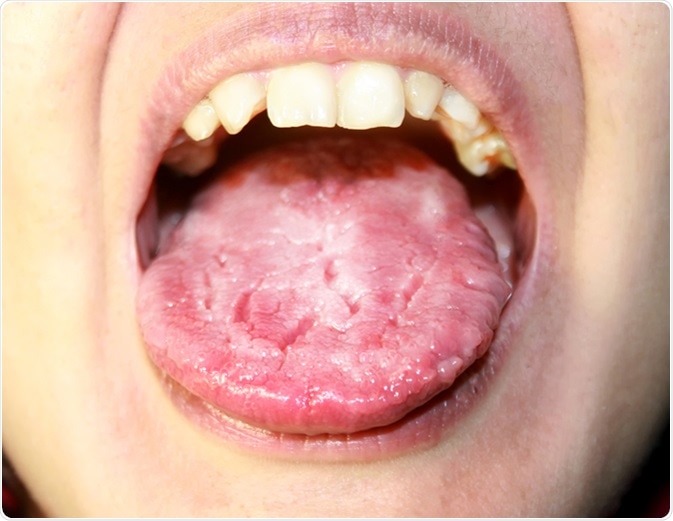Oral candidiasis, commonly known as oral thrush, is a fungal infection that occurs inside the mouth. It is not contagious and in most cases can be treated with a simple course of topical antifungal medication applied directly to the affected area in the mouth.
The condition is most common in people who are very young, elderly or already in ill health. People with HIV are most likely to be affected, and it is estimated that 95% of all HIV patients will experience symptoms of oral thrush at some time. It is also more common in patients taking immunosuppressant therapies, such as those used in the treatment of cancer.

Candidiasis on the tongue. Image Credit: Timonina / Shutterstock
Cause
Oral thrush may present when there is a change in the growth of the fungus Candida in the mouth. Candida is naturally present in the mouth of most people, but certain circumstances can change the environment in the mouth and lead to overgrowth of the fungus, causing symptoms.
Candida albicans is the most common type of fungus to cause oral candidiasis but there are several other species that may be responsible is some cases, such as C. krusei, C. parapsilosi, C. glabrata, C. tropicalis and C. dubliniensis.
Factors that may increase the risk of oral thrush include:
- Certain medications (e.g. antibiotics, inhaled corticosteroids, immunosuppressant drugs)
- Underlying medical conditions (e.g. HIV, diabetes, hypothyroidism, nutritional deficiencies)
- Use of ill-fitting dentures
- Smoking
Signs and Symptoms
The appearance of white patches or plaque in the mouth that can be wiped off is characteristic of oral thrush. The mouth and throat may appear to be reddened, and cracks at the corners of the mouth are also common.
The condition can also cause an unpleasant taste in the mouth, as well as a painful or burning sensation. This may make eating or drinking difficult in some cases.
Diagnosis
It is important for oral thrush to be diagnosed as early as possible so that the condition can be treated and the risk of complications, such as the spread of the infection to other areas of the body, is reduced.
A general practitioner can usually make a diagnosis with a simple examination of the mouth. In some cases, blood tests may also be taken to investigate certain causes of the condition, such as diabetes or dietary deficiencies.
Treatment
Oral candidiasis is most commonly treated with antifungal medications to control the growth of Candida in the mouth. Topical treatment with a liquid or gel that can be applied directly to the affected area in the mouth is usually recommended to reduce systemic effects on the rest of the body; however, systemic oral tablets or capsules may also be recommended in some cases.
If there are any particular factors that may have contributed to causing the condition, such as smoking, certain medication or untreated health conditions, these should be managed appropriately.
Prevention
It is important for people who are at risk of or have been affected by oral thrush to use preventative techniques to reduce the risk of recurrence. These include the following:
- Brush teeth twice a day and floss daily
- Rinse mouth after meals
- If using inhaled medications, rinse mouth after use
- Ensure any dentures are well-fitted and remove them at night
- Reduce intake of sugary foods
- Maintain adequate fluid intake
- Avoid smoking
Each of these tips can be helpful to prevent oral candidiasis and should be continued on an ongoing basis.
References
Further Reading
Last Updated: Feb 27, 2019